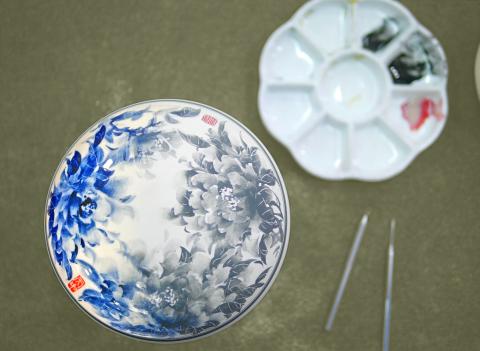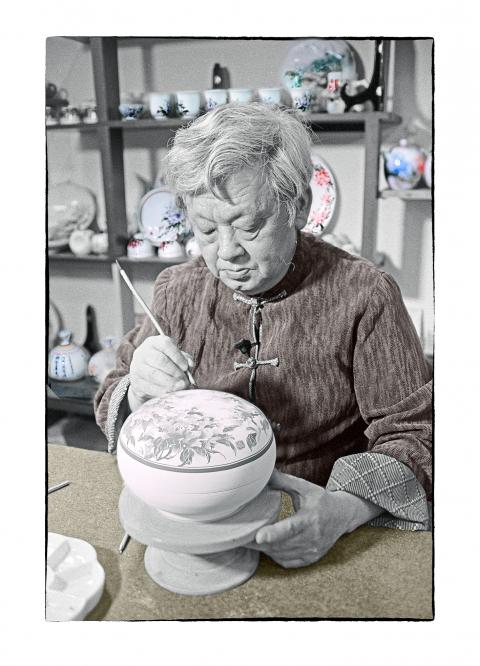Take a look at the photo of the lidded pot. How long do you think it took to paint?
Yingge (鶯歌) artist Chang Sung-shan’s (張松山) brush dances over the lid as he talks of his life, his art, his plans. I assume he’s just distractedly doodling during our interview.
As we conclude, I walk over and look at what he’s been doing. He has painted a fully-formed, complex, multilayered, monochromatic floral composition in the muted gray of the unfired cobalt underglaze pigment. It took him less than 30 minutes.

Photo: Paul Cooper, Taipei Times
Six years ago, Chang returned to painting following a career serving in the armed forces. He has chosen to paint on ceramics. His challenges now are two historically entrenched mindsets biased against his art — the dominance of the Western-Chinese hybrid style introduced during the early Qing dynasty and the idea that painting on ceramics can only be considered a handicraft, not an art form — as well as an anemic market for his work in Taiwan.
Chang’s style predates Qing dynasty court painting techniques. The Italian Jesuit priest Giuseppe Castiglione (郎世寧), who served under the early Qing emperors Kangxi (康熙), Yongzheng (雍正) and Qianlong (乾隆), introduced Western painting ideas such as vanishing perspective, meticulous, detailed brushwork and a tendency to fill the entire canvas. Castiglione’s hybrid style has heavily influenced Chinese painting since.
Chang still follows the traditional academic school (學院派), which he says has its roots in antiquity. This school concentrates on painting in the traditional xieyihua (寫意畫, describing ideas) style and moyun (墨韻, the poetic flow of the ink), eschewing gaudy colors and favoring the use of negative space to convey ideas.

Photo: Paul Cooper, Taipei Times
“You don’t need to fill everything with paint: you give people space in which to use their own imagination,” Chang quips.
Chang says that traditional Chinese ink painting is quickly disappearing. Teachers nowadays teach the hybrid Western-Chinese style, and many artists have trained in Western painting.
The painter set up shop in Yingge District six years ago, thinking to combine the expertise of this pottery-making area and the painting skills he mastered before he joined the military.
Few others in Yingge paint underglaze blue directly on ceramics, so there’s little competition in that regard. Transitioning from painting on paper to painting on the surface of unfired ceramics came quickly to Chang. The problem has been overcoming the idea that painting on ceramics cannot be considered an art form.
Ming and Qing underglaze blue vases were generally decorated by craftsmen, not painters. Chang has a lot of respect for the tradition of painting in underglaze blues — “it’s the only thing that can really convey the ancient tradition” — and favors this technique over polychromatic overglaze colors.
Chang points to oil painting in Western churches and cathedrals, on ceilings and walls, to illustrate that painting doesn’t necessarily have to be done on paper for it to be considered art. He believes that art is about expression. The medium it is painted on is beside the point.
“A work of art is a unique object that the maker has put their all into conveying their ideas, has tried their utmost to make as beautiful as they can,” he says.
While the ceramic medium presents its own inherent problems as a canvas, there is also much to recommend it. So many factors must come together to create a perfect piece: the skill of the potter, the quality of the porcelain, the technique of the painter, and flawless application of the transparent overglaze, together with a bit of luck in the firing process.
“You have no idea if the firing will go well, whether it will be successful or not, or whether there will be any natural phenomena, such as impurities or contaminants,” Chang says.
If all goes well, however, the result is an object of beauty and practical use that could last for thousands of years. At the moment, Chang is trying to establish a name for himself in China.
“There is no market in Taiwan,” he says. In China, however, there is money, and people there are more prepared to spend money on his art.
Last July he exhibited in Beijing, and found a group of collectors interested in his brand of painting.
“They haven’t seen an artist, able to paint in the style of the ancients that they miss, appearing on the scene for a long time,” he adds.
— Additional reporting by Louis Jia-yu Wei
Yingge Town Artisan is a monthly photographic and historical exploration of the artists and potters linked to New Taipei City’s Yingge Town.

May 11 to May 18 The original Taichung Railway Station was long thought to have been completely razed. Opening on May 15, 1905, the one-story wooden structure soon outgrew its purpose and was replaced in 1917 by a grandiose, Western-style station. During construction on the third-generation station in 2017, workers discovered the service pit for the original station’s locomotive depot. A year later, a small wooden building on site was determined by historians to be the first stationmaster’s office, built around 1908. With these findings, the Taichung Railway Station Cultural Park now boasts that it has

The latest Formosa poll released at the end of last month shows confidence in President William Lai (賴清德) plunged 8.1 percent, while satisfaction with the Lai administration fared worse with a drop of 8.5 percent. Those lacking confidence in Lai jumped by 6 percent and dissatisfaction in his administration spiked up 6.7 percent. Confidence in Lai is still strong at 48.6 percent, compared to 43 percent lacking confidence — but this is his worst result overall since he took office. For the first time, dissatisfaction with his administration surpassed satisfaction, 47.3 to 47.1 percent. Though statistically a tie, for most

Wooden houses wedged between concrete, crumbling brick facades with roofs gaping to the sky, and tiled art deco buildings down narrow alleyways: Taichung Central District’s (中區) aging architecture reveals both the allure and reality of the old downtown. From Indigenous settlement to capital under Qing Dynasty rule through to Japanese colonization, Taichung’s Central District holds a long and layered history. The bygone beauty of its streets once earned it the nickname “Little Kyoto.” Since the late eighties, however, the shifting of economic and government centers westward signaled a gradual decline in the area’s evolving fortunes. With the regeneration of the once

In February of this year the Taipei Times reported on the visit of Lienchiang County Commissioner Wang Chung-ming (王忠銘) of the Chinese Nationalist Party (KMT) and a delegation to a lantern festival in Fuzhou’s Mawei District in Fujian Province. “Today, Mawei and Matsu jointly marked the lantern festival,” Wang was quoted as saying, adding that both sides “being of one people,” is a cause for joy. Wang was passing around a common claim of officials of the People’s Republic of China (PRC) and the PRC’s allies and supporters in Taiwan — KMT and the Taiwan People’s Party — and elsewhere: Taiwan and